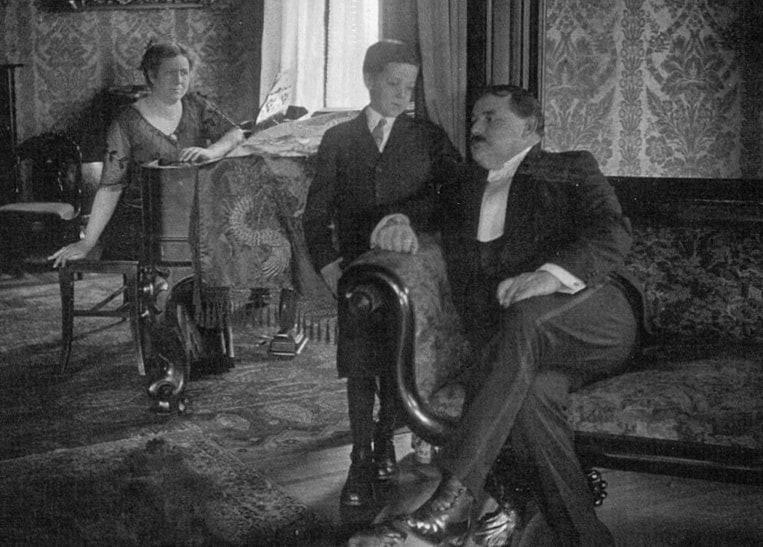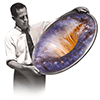This is Chapter 4 from The Man Who Mastered Gravity, now available from Amazon and fine booksellers everywhere.
4
The Second Edison
(1915)

In the spring of 1915, a visitor to the home of Mr. and Mrs. Lewis K. Brown in the posh Terrace section of Zanesville, Ohio, observed a lad of about ten years walking along the wrought-iron fence that ringed the estate, casually picking earthworms off the surface of the manicured lawn and dropping them into a bucket.
“What are you doing?” the visitor asked.
“I’m collecting worms,” the boy replied.
“But you’re not digging for them. They’re just wiggling along on the surface!”
“That’s because I’ve electrified the fence,” the boy said, pointing to a battery he had connected to the metalwork. “The electricity in the soil excites the worms and brings them to the surface.”
“So what will you do with all these worms?”
“I’m going fishing.”
*
Thomas Townsend Brown was born to one Zanesville’s most prominent families on March 18, 1905 – the same year an obscure Swiss patent clerk named Albert Einstein published a scientific paper on the subject of ‘Special Relativity.’
As the only male of his generation, Thomas was expected to take the reins of a family fortune that began with the boy’s maternal grandfather. Thomas Burgess ‘T.B.’ Townsend was a second generation American. His own parents, William Townsend and Harriet Burgess, met somewhere on the North Atlantic, aboard the ship that brought them both to New World from their native Gloucestershire in England in 1834 or 1835. The couple was married in Pittsburgh, and T.B. was the first of their thirteen children. A hagiographic family history says T.B. Townsend “did not have a dollar when he started out in life.” His formal schooling ended when he was nine years old, “his total attendance at school covering just six months.”
As a teenager, T.B. apprenticed to his father’s brick and stone mason’s trade in Beverly, Ohio. At the age of nineteen he “started out for the distant west.” Traveling by steamboat up the Mississippi River to Burlington, Iowa, he found work cutting and laying stone for the state’s new Governor’s Mansion.
Some years later, T.B. returned to Beverly and took over his father’s contracting business, “…carrying on the business with constantly growing success…his patronage constantly increasing in volume and importance.” He expanded his interests to include marble and granite quarries, and when those business flourished he moved his operations to Zanesville, which was at the time “the center of operations of wholesale dealers in marble and granite.”
In the final decades of the 19th century, T.B. Townsend supplied the building stone for much of Zanesville and surrounding Muskingum County, including the classically ornate Tuscawaras County courthouse, which stands today as a testament to the extravagance of the Gilded Age.
With the arrival of the new century, T.B. created much of the infrastructure of the area, starting with Zanesville’s first street car system. After selling his interest in that enterprise, he began to pave “the greater part of the streets of Zanesville and built most of the sewers.” Furnishing stone from his own quarries, he constructed foundations for more than a dozen bridges across the Muskingum River.
Among his “other important investments,” Mr. Townsend was most proud of his “extensive and valuable ranch of thirty-six hundred acres in Marion County, Kansas” which raised, among other things “cattle, hogs, horses, corn, alfalfa and sorghum hay.” With a perimeter fence stretching more than 50 miles, Mr. Townsend could count among his assets some 16,500 fence posts strung with more than 200 miles of barbed wire.
T.B. Townsend’s wife, Sybil Nulton Townsend, bore five children, three of whom survived into adulthood: Eldest son Orville served as vice-president and general manager of the Townsend Brick and Contracting Company; Daughter Hattie married Rufus Burton, who served as the secretary and treasurer; Daughter Mary and her husband L.K. Brown bore the next generation’s sole male heir, Thomas Townsend Brown.
In the expressive language of the day, T.B. Townsend’s 1905 biography extols “…the extent and importance of the business interests which have claimed his attention and the success which has attended his efforts makes his history a notable one….he is a man of distinct and forceful personality, broad mentality and mature judgment and in his ready recognition and utilization of opportunity is found the secret of his prosperity.”
Such were the shoes that the boy who electrified earthworms was expected to fill.
*
In deference to his mother, Thomas chose to be called by his middle name. His experiments with electricity led him to build his first wireless set in 1917, when radio was still only useful for transmitting Morse code. His efforts drew the attention of one of the local papers with the headline, “Townsend Brown Has A Complete Wireless Set.”
Calling him ‘Zanesville’s second Edison,’ the story noted that the he could barely understand the coded messages he was receiving: “Master Brown has paid most of his attention to the mechanical side of wireless telegraphy, and is not yet able to read messages with proficiency. He is practicing hard, however.” Another of his gadgets was described as “…a wireless telephone. When he is at play away from home, he wears a wireless telephone over his ear. Members of the family are able to call him wherever they want to, merely speaking into the wireless transmitter in the house, and he can hear them perfectly.”
The young prodigy’s experiments also caught the attention of the federal government. With The Great War unfolding in Europe, an officer from the Post Office showed up at the Brown’s home to request that he dismantle the antenna he had mounted on the roof. A rumor was circulating that the boy could pick up radio signals from Germany; the authorities were afraid that somebody could also use the apparatus to send messages to the enemy.
That was Thomas Townsend Brown’s first brush with national security.
*
Few records survive of the boy’s schooling, with scant evidence of any merit or distinction.
In 1922 and 1923 Townsend attended Doane Academy in Granville, midway between Columbus and Zanesville in central Ohio, a tree-lined village with a church at each corner of the main intersection. Looming from a hill above the town is the campus of Denison University, founded in 1831 by the Ohio Baptist Education Society and named for William S. Denison – also of Zanesville – in gratitude for his generous contribution to the school’s endowment.
At the edge of the campus stood Denison University’s most distinctive structure, the Swazey Observatory – a rectangular concrete building with a white, rotating, dome-topped turret. Considered one of the finest academic observatories in the country, from 1911 until 1934 the observatory’s was administered by school’s Professor of Astronomy, Dr. Paul Alfred Biefeld.
Townsend spent two years at Doane, preparing to enroll at Denison after graduation in 1923, earning mostly B’s and C’s in courses like Latin, Algebra, and English. His only A’s were in Physics and History.
He was more proud of the school’s first radio station, which he built around a DeForest Audion tube that had been personally supplied by Lee DeForest after Brown tracked the inventor down during a trip to New York with his mother. With a mere ten-watt signal, Denison Station 8YM could be heard as far away as California. Saturday nights, the station broadcast a performance by a local band, The Green Imps. When the school tried to shut off power to the radio station in order to impose a 10:00 PM curfew, Townsend built his own Delco generating station and kept the music going well into the night
In personal memoir composed years later, Brown sums up his academic career by recalling, “I slept in the Physics room.”
(this chapter is an excerpt from The Man Who Mastered Gravity, to be published in 2023; to be notified when the book is available, please subscribe to our mailing list)
